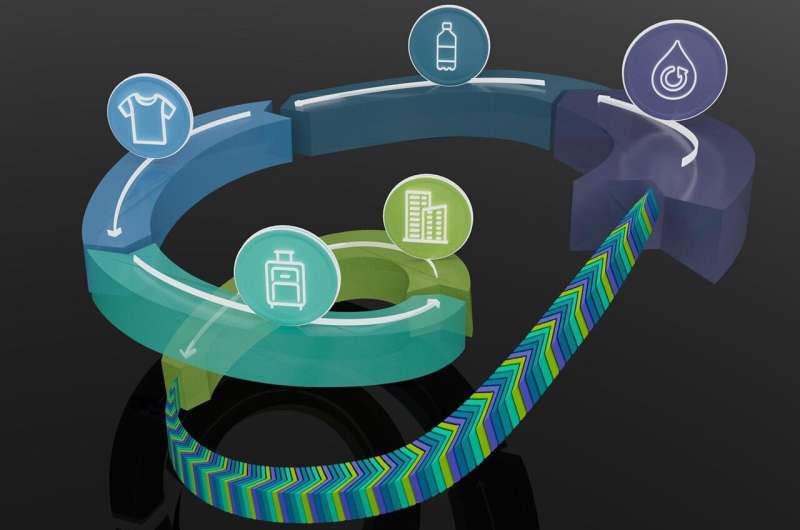A new roadmap to close the carbon cycle
A major approach to achieving net-zero carbon emissions relies on converting various parts of the economy, such as personal vehicles and heating, to run via electricity generated from renewable sources. But carbon cannot be removed from all parts of society. Plastics, ubiquitous in the modern world, cannot be decarbonized because they are made of carbon-based molecules.
Led by chemist Wendy Shaw of Pacific Northwest National Laboratory (PNNL), a multi-institutional effort has produced a new roadmap to reducing emissions in hard-to-electrify segments of the economy. The multifaceted approach includes developing non-carbon fuels, finding non-fossil sources of carbon, and keeping carbon in play once it enters the cycle, ideally resulting in multiple uses of each carbon atom.
Single-use carbon can no longer be widespread, the roadmap authors assert. The carbon must be kept in play through a circular economy where each carbon atom is used numerous times. The carbon can be reused within the same industrial sector or act as a feedstock for a new industrial sector. For instance, developing polymer upcycling processes and efficiently reusing carbon-based materials will be central to a net-zero carbon emissions future.
“We need novel and creative solutions to realize our decarbonization goals,” said PNNL Director Steven Ashby. “Collaboration is key to accelerating the use-inspired scientific research in catalysis and separations science that will underpin these solutions. I eagerly await these results and their deployment in aviation, heavy-duty trucking, and marine transportation.”
The ideas emerged from a workshop on “Closing the Carbon Cycle,” jointly hosted by PNNL, Ames National Laboratory, Argonne National Laboratory, Brookhaven National Laboratory, Lawrence Berkeley National Laboratory, Oak Ridge National Laboratory, and the SLAC National Accelerator Laboratory. Leads from each laboratory included Shaw, James Morris, Max Delferro, Sanjaya Senanayake, Francesca Toma, Michelle Kidder, and Simon Bare, respectively.
“Advancing carbon recycling and conversion technologies is key to a clean energy future, and Argonne is committed to supporting its development,” said Argonne Director Paul Kearns. “I commend the researchers who are collaborating across the Department of Energy national lab complex to drive these transformative innovations to achieve net zero by 2050.”
A roadmap to decarbonization
Hydrogen and ammonia both have potential as carbon-free fuels. However, both have clear challenges for implementation. In particular, the cost to store and transport hydrogen makes it impractical with current technologies. Work to develop carrier molecules and materials to enable safe and affordable hydrogen transportation will complement the Department of Energy’s Hydrogen Earthshot goal of renewably producing hydrogen for $1/kilogram or less. This cost reduction could help create viable hydrogen-based systems.
Using carbon from diverse sources is central to the proposed approach. Carbon will continue to be essential for many critical economic sectors. These sectors are candidates for circular carbon cycling through recycling and incorporating multiple carbon sources. Possible sources of valuable carbon include biomass, food waste, and plastic waste.
Making this process a reality requires effective and efficient separations and conversions because complex mixtures make up most non-fossil carbon streams.
“Carbon should be seen as a valuable commodity that must be conserved and reused,” said Shaw, Chief Science and Technology Officer of PNNL’s Physical and Computational Sciences Directorate. “Our vision is to transform the role of carbon in our economy by reusing each carbon atom multiple times in a circular economy.”
Effectively transforming “traditional” waste materials into reusable materials remains critical. Combining the separation and conversion steps through reactive separations may provide a practical approach. Reactive separations combine chemical reactions with purifying separations and can provide process intensification, converting the non-fossil carbon more efficiently.
“We need new fundamental science developments to produce integrated industrial approaches,” said Morris. “The resulting technologies will create new economic opportunities, educational development, and additional job growth.”
The roadmap presents a future without waste, where carbon is treated as a precious commodity rather than a disposable resource. Bringing sustainable sources of carbon into the carbon-circle economy is essential to this future.
The full article is available in Nature Reviews Chemistry.
More information:
Wendy J. Shaw et al, A US perspective on closing the carbon cycle to defossilize difficult-to-electrify segments of our economy, Nature Reviews Chemistry (2024). DOI: 10.1038/s41570-024-00587-1
Pacific Northwest National Laboratory
Citation:
A new roadmap to close the carbon cycle (2024, May 1)
retrieved 2 May 2024
from https://techxplore.com/news/2024-05-roadmap-carbon.html
This document is subject to copyright. Apart from any fair dealing for the purpose of private study or research, no
part may be reproduced without the written permission. The content is provided for information purposes only.

Comments are closed